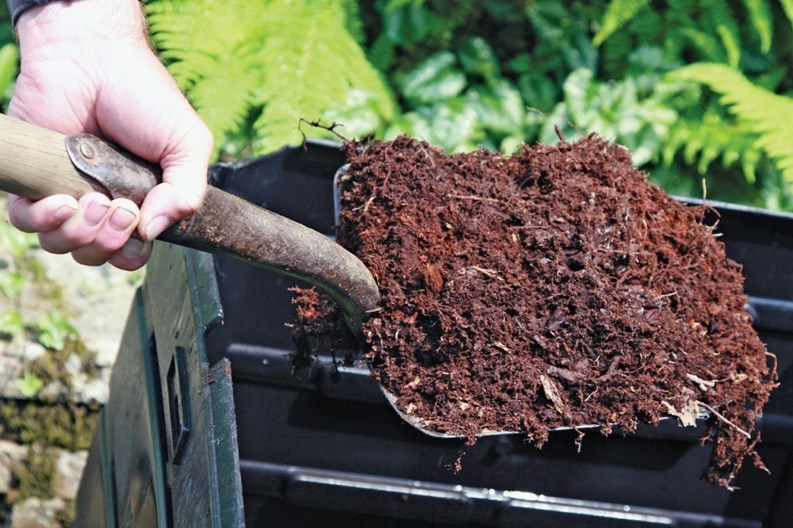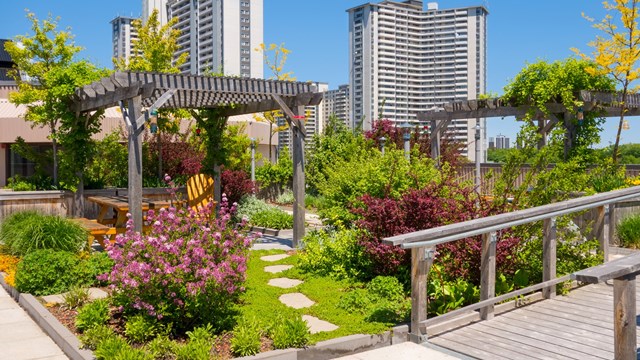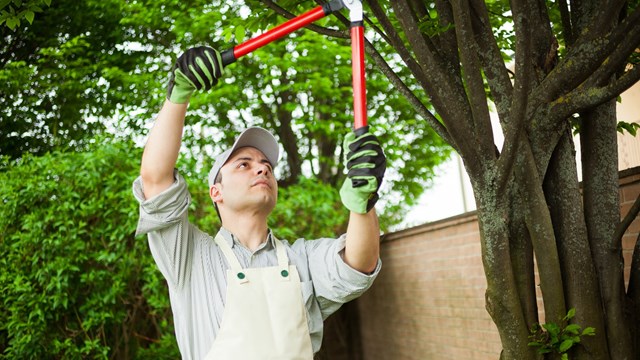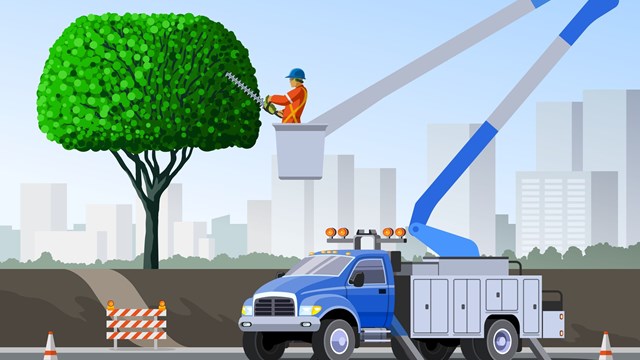The most common method of maintaining a landscape has typically been: “mow, apply a generous and regular supply of man-made fertilizers and pesticides to prevent weeds, water and repeat.” But just because it’s the most widespread doesn’t mean it’s the healthiest process for the lawn, the condominium owners and the environment.
Excess mowing and water usage, combined with the possible dangers ofpesticide exposure to humans and the environment, are reasons to consider converting to a more natural, low-maintenance way of taking care of the association’s landscape.
“Organic landscaping is without the use of harmful synthetic pesticides andfertilizers,” says Dan Corra, business manager of Plantscapes Organics Inc., in Fairfield, Connecticut. “It’s not only about the methods and materials used but also a mindset on how to approach the care of our landscape and the living systems around us.”
He explains that organic landscaping consists of many components, such as using only organic materials – including fertilizers, and weed-, insect- and disease-control products – testing the soil, creating a low-maintenance sustainable landscape, composting, aerating, overseeding, managing stormwater, choosing the right plants, and mowing properly.
Many Benefits
Organic landscaping comes with a number of benefits. The first benefit is safety. When chemicals are applied in synthetic landscaping, all residents must stay off the lawn for a period of time. “With organic landscaping, it’s safe for all residents to walk on the lawnwithout worrying about bringing them (chemicals) in the house,” says Javier Gil, of J. Gil Landscaping in Newburyport, Massachusetts.
On a bigger scale, going organic also prevents these toxins from getting intothe water supply. “It keeps our water safe by limiting hazardous runoff (of pesticides) and seepage into our lakes, streams, and rivers, preserving the health of soil and soil food web, and helps to protect the health of the wildlife and living ecosystems around us,” says Corra.
Another benefit of organic landscaping directly affects the association’s bottom line, although many consumersmistakenly associate organic practices with more expense than conventional methods.
“Usually in the first year you save 50 percent in water costs because you waterless frequently,” says Gil. “Chemicals are water soluble, so they need water to decompose. With organic, you water deeply so the water gets down deep into the root system.”
“Depending on the intensity of the organic program, there are services that will result in higher costs if consumers elect to have those services performed,” says Corra. “In some cases, depending on the type of services offered, the material cost is higher than that of conventional landscaping. The cost of an organic program will be mainly determined by which services the community wants done and the overall size and scale of the property.”
Weed Control Initially Suffers
Paul Tukey, author of "The Organic Lawn Care Manual," says that there is really only one drawback to organic landscaping — and that’s weed control. “If you have the expectation that your condo grounds need to be weed free, that’s challenging in the first year or two of organics,” he says. “There is nosuch thing as selective organic herbicides that can kill the dandelions, etc. but allow the grass to live. It doesn’t exist yet.”
Some weeds are even helpful. He explains that prior to the 1970s, the most prominent ‘lawn plant,’ as he called it, was clover, a great soil food.
“The best lawns come with the mostclover; it’s evergreen and drought tolerant,” says Tukey. “Marketing hits and everyone wanted their lawns to look like the outfield at Fenway Park or the Masters Golf Tournament. Suddenly the expectations on the groundskeepers went through the roof and they started using chemicals on the weeds. Clover is important to the soil. It also keeps insects happy and healthy. If you don’t have clover, you have to start using fertilizer.”
Tukey remembers visiting a large hotel in Maine that looked fantastic, but the innkeeper was upset because there was clover on the grass. “Clover is a natural component and it saves onyour bill,” he says. “If your residents are going to freak out because of clover, educate them that it’s natural, or perhaps you’re not ready for an organic lawn.”
Gil also cautions that your lawn might get worse before it gets better. “If a property has been chemically-maintained, most likely the yard will crash and then you’ll see weeds; that’s normal,” he says. “Think of them as telling you something about the soil. For example, if you see crabgrass, yoursoil is compacted and you need to aerate. If you see dandelions, there’s a deficiency.”
By working with the clover, by the third or fourth year, Tukey says that you won’t have to apply fertilizers to your lawn either, saving money on those products. “The ground will be cycling the nutrients in the soil and allowing clover to generate fertilizer for you,” he says.
Getting Started
So where do you start? “The focus of an annual organic landscaping program is on the soil,” says Tukey. “Forget the Miracle-Gro, which feeds the plants. If the soil is dead, these products don’t work. Organic fertilizers feed the soil and will be consumed by the organismsin the soil first before the plant gets them.”
Have a sample of your property’s soil tested by a local lab or cooperative extension. It’s recommended that testing be done in early spring or by mid-March in New England, after the snow melts. One such lab, The Soil and Plant Tissue Testing Laboratory, is located on the campus of the University of Massa-chusettsat Amherst and conducts soil testing and offers recommendations.
“You’ll learn whether or not the soil’snutrients are in balance and you have nothing to do that year, or whether the pH is light and you need to apply lime,” says Gil. “It’s like going to the doctor and having a physical so you can plan ahead for the season.”
Tukey also recommends a bioassay – a “blood count” and “CAT scan” of the soil – which inventories the bacteria and fungi in the soil and how to improve it, especially if the association is planning a substantial renovation or construction.
Next, Gil recommends proper aeration, fertilizing and mowing, which means keeping the grass at three inches tall. “Make sure you water deeply oncea week and spread a thin layer of compost on top of the grass,” he says.
This could mean leaving the grass clippings behind, which saves the time and money of disposing of them. “Within a couple of days they will disappear because they are 98% water,” says Gil.
It’s important to select the right plants for the area, says Corra. “Conventional landscaping tends to gravitate toward the more popular nursery (raised), maintenance-driven and industrial plants that if the soil and climate does not support them, then we alter the conditions by removing existing soil, bringing in new untested soil, unnecessarily adding irrigation, top dressing with ornamental mulches, and introducing the need for synthetic pesticidesand fertilizers to maintain them,” says Corra. “At times, it can result in a mundane and boring landscape.”
Instead, Corra suggests using plants that are indigenous to the area. “Native plants grow under local conditions and do not require that the site be changed,” he says. “They do not need the life support of watering (except during establishment) or regular synthetic chemicals. They do not require fertilizer beyond that provided naturally and they are not prone to the diseases of many industrial plants.” (See the sidebar for some good plant choices.)
To learn more, it’s recommended that management or building staff work with a landscaper who is accredited as an organic land care professional through the Northeast Organic Farming Association Organization (NOFA). NOFA offers a five-day course on all areas of organic land care in which interested parties can become accredited. Students must pass a test to become accredited and are required to take continuing education credits to keep the accreditation.
NOFA also promotes organic farming and gardening with summer farm and garden tours, fall and spring workshops, an annual winter conference, quarterly chapter newsletter, displays at fairs and festivals, and annual bulk buying of soil amendments and cover crop seeds.
Patience Needed
When it comes to a successful organic lawn, patience is a virtue. “It can take six months to a year to see any results,” says Tukey.
There are no shortcuts to creating the right organically-landscaped property, says Corra. “However, by simply replacing some synthetic materials with organic materials and practices, you are on your way to adopting an organic program,” says Corra. “You could take on a transitional program where all organic materials and methods will be used unless a problem arises that simply cannot be corrected without theuse of chemicals. After the problem is corrected, the landscaping reverts to organic materials and methods.”
He admits that it can sometimes be a challenge to adopt an organic landscaping program in condominiums because the values and needs of individual unit owners tend to differ. “Some see the value in it while others aren’t as concerned,” he says. “Typically, condominiums will choose landscapers based on cost without necessarily considering the methods used in admin-istering the services. I think if you can offer an organic program that falls in line with the cost of a conventional program, it’s easy to go in that directionand is always recommended.”
He urges that associations check references of landscapers who say they are using organic methods and contactNOFA to verify their accreditation. “I would be wary of any landscaping company offering an organic program who is not accredited under NOFA,” he says.
There are many misconceptions about organic landscaping. The truth, however, is that by actively caring for the soil in your lawn as well as the grass, you can create a healthier lawn. Homeowner associations can rest assured that there are cost-effective landscaping methods available today that not only safeguard the environment but also the health and well-being of the community.
Lisa Iannucci is a freelance writer and a frequent contributor to New England Condominium magazine.







Leave a Comment